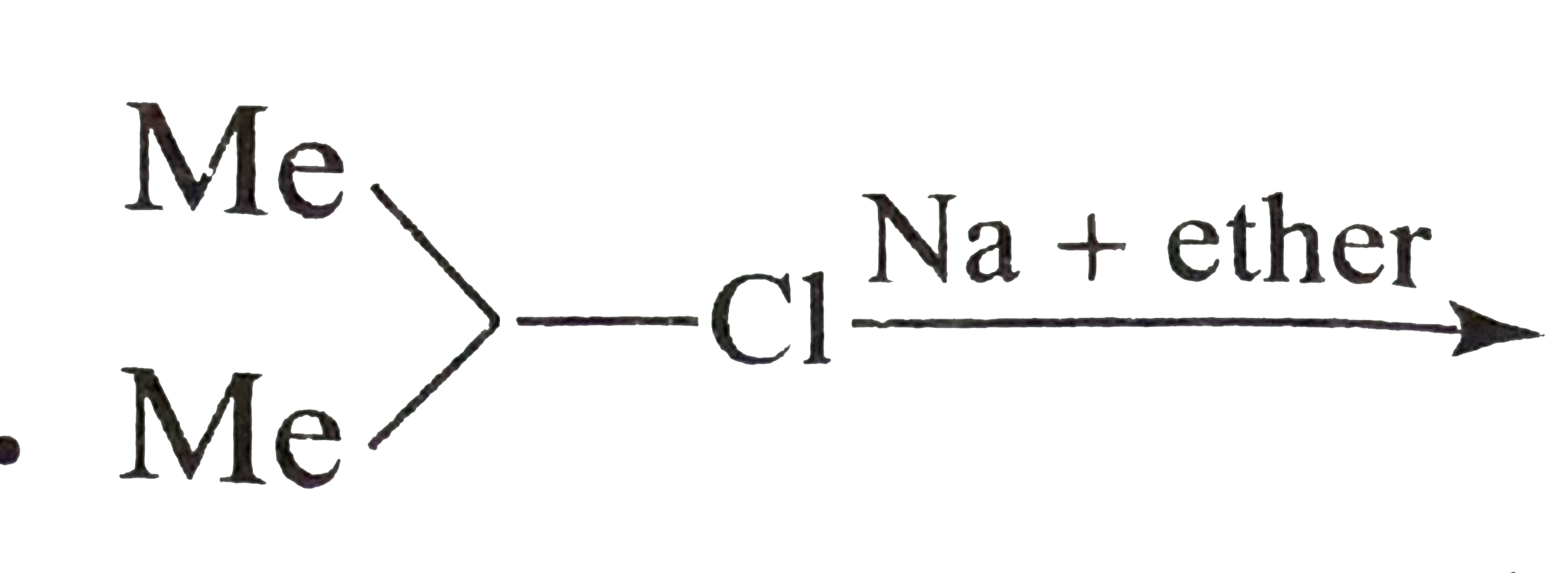(CH3)2CHIKOH−−−→EtOHASO2Cl2−−−→475KB
The compound B in the sequence is
Dimethyl sulphate
1,2−− Dichloro ethane
3− Chloro propene
1− Chloro−2− iosopropane
The correct Answer is:c
To solve the given question, we will break down the reaction sequence step by step.
Step 1: Identify the Starting Compound
The starting compound is (CH₃)₂CHI, which is 2-iodopropane. This compound has three carbon atoms and is a secondary alkyl halide.
Step 2: Reaction with KOH in Ethanol
When 2-iodopropane reacts with alcoholic KOH (KOH in ethanol), it undergoes an elimination reaction (dehydrohalogenation). In this reaction, the iodine atom (I) and a hydrogen atom (H) from the adjacent carbon are removed, leading to the formation of an alkene.
- Elimination Reaction:
- The H atom is removed from the carbon adjacent to the carbon bearing the iodine.
- The I atom is removed from the carbon that has it.
This results in the formation of propene (C₃H₆), which has the structure:
CH2=CH−CH3
Step 3: Identify the Product A
The product formed from the first reaction is propene (C₃H₆). We will denote this compound as A.
Step 4: Reaction with SO₂Cl₂
Next, propene (A) reacts with sulfur dichloride (SO₂Cl₂) at elevated temperature (475 K). This reaction involves the halogenation of the allylic carbon, which is the carbon adjacent to the double bond.
- Halogenation:
- The chlorine atom from SO₂Cl₂ will add to the allylic carbon (the carbon adjacent to the double-bonded carbon).
In propene, the allylic carbon is the one next to the double bond. Therefore, the chlorine will substitute for a hydrogen atom on this carbon.
Step 5: Identify the Product B
The final product formed from the reaction of propene with SO₂Cl₂ is 3-chloropropene. The structure of 3-chloropropene is:
CH2=CH−CH2Cl
Conclusion
Thus, the compound B in the sequence is 3-chloropropene.
Summary of Steps:
1. Identify the starting compound (2-iodopropane).
2. React with alcoholic KOH to form propene (A).
3. React propene with SO₂Cl₂ to form 3-chloropropene (B).
The starting compound is (CH₃)₂CHI, which is 2-iodopropane. This compound has three carbon atoms and is a secondary alkyl halide.
When 2-iodopropane reacts with alcoholic KOH (KOH in ethanol), it undergoes an elimination reaction (dehydrohalogenation). In this reaction, the iodine atom (I) and a hydrogen atom (H) from the adjacent carbon are removed, leading to the formation of an alkene.
- The H atom is removed from the carbon adjacent to the carbon bearing the iodine.
- The I atom is removed from the carbon that has it.
This results in the formation of propene (C₃H₆), which has the structure:
The product formed from the first reaction is propene (C₃H₆). We will denote this compound as A.
Next, propene (A) reacts with sulfur dichloride (SO₂Cl₂) at elevated temperature (475 K). This reaction involves the halogenation of the allylic carbon, which is the carbon adjacent to the double bond.
- The chlorine atom from SO₂Cl₂ will add to the allylic carbon (the carbon adjacent to the double-bonded carbon).
In propene, the allylic carbon is the one next to the double bond. Therefore, the chlorine will substitute for a hydrogen atom on this carbon.
The final product formed from the reaction of propene with SO₂Cl₂ is 3-chloropropene. The structure of 3-chloropropene is:
Thus, the compound B in the sequence is 3-chloropropene.
1. Identify the starting compound (2-iodopropane).
2. React with alcoholic KOH to form propene (A).
3. React propene with SO₂Cl₂ to form 3-chloropropene (B).
Topper's Solved these Questions
- AROMATIC COMPOUNDS AND ALKYL AND ARYL HALIDES BOOK - CENGAGE CHEMISTRY ENGLISHCHAPTER - AROMATIC COMPOUNDS AND ALKYL AND ARYL HALIDES EXERCISE - Exercises Assertion-Resoning Type
1 Video
- AROMATIC COMPOUNDS AND ALKYL AND ARYL HALIDES BOOK - CENGAGE CHEMISTRY ENGLISHCHAPTER - AROMATIC COMPOUNDS AND ALKYL AND ARYL HALIDES EXERCISE - Exercises Assertion-Resoning
11 Videos
- AROMATIC COMPOUNDS AND ALKYL AND ARYL HALIDES BOOK - CENGAGE CHEMISTRY ENGLISHCHAPTER - AROMATIC COMPOUNDS AND ALKYL AND ARYL HALIDES EXERCISE - Exercises Single Correct Answer Type
28 Videos
- APPENDIX INORGANIC VOLUME 2BOOK - CENGAGE CHEMISTRY ENGLISHCHAPTER - APPENDIX INORGANIC VOLUME 2EXERCISE - Short Answer Type
179 Videos
- BIOMOLECULESBOOK - CENGAGE CHEMISTRY ENGLISHCHAPTER - BIOMOLECULESEXERCISE - Exercises Archives (Analytical And Descriptive)
8 Videos
Similar Questions
Knowledge Check
Cl−CH2−CH3∣C∣CH3−CH2−CH2−Cl+l−−−→DMF product, Major product of this reaction is:
Al−CH2−CH3∣C∣CH3−CH2−CH2−ClBCl−CH2−CH3∣C∣CH3−CH2−CH2−l−CH2C=CH3∣C−CH2−CH2=ClDCl−CH2−CH3∣C∣CH3−CH2=CH2Identify C in the following series C3H7IKOH−−→alc.ANas−−→ΔBKCN−−→alc.C
A(CH3)2CH−CNBCH2=CH−CH2CNCBr−CH=CH−CNDCH2=CH−C∣BrHCN
2HC≡CHCH2Cl2−−−−−→+NH4Cl(A)1mol−−→HCl(B)
Compounds (A) and (B) are:
View Solution (i)CH3CHO−−−−−−−→(ii)H3O+ (A) HBr−−→ (B)
(i)CH3CHO−−−−−−−→(ii)H3O+ (A) HBr−−→ (B)
The compounds (A) and (B)
View Solution(CH3)2CHOHMild−−−−−−→oxidation[O](X)(i)CH3Mgl−−−−−−−−→(ii)Hydrolysis(Y)
In the above sequence of reaction, (Y) is:
View Solution(CH3)2CONaCN−−−→HCI(A)H+3O−−→Δ(B)
In the above sequence of reactions, (A) and (B) are :
View SolutionCH3CH2COOHCl2/Fe−−−−→(X)Alc.−−→KOH(Y)
Compound (Y) is :
View SolutionF3C−CH=CH2HBr−−→(A)Nal−−−−−−−−−→dry.acetone(B)
View Solution

 (B)
(B)